A rotary evaporator is a sophisticated piece of laboratory equipment designed to efficiently remove solvents from samples through evaporation. Its key components work in harmony to achieve this goal. The rotary motor rotates the evaporation flask, increasing the surface area for evaporation and ensuring even mixing. The vacuum source reduces pressure within the system, lowering the boiling point of the solvent. The heating bath provides controlled heat to the sample, while the condenser cools and recondenses the evaporated solvent into liquid form, which is then collected in the receiving flask. This process is widely used in chemical, pharmaceutical, and food industries for tasks such as solvent recovery, concentration, and purification.
Key Points Explained:

-
Rotary Motor
- Function: Rotates the evaporation flask.
- Purpose: Increases the surface area of the sample by spreading it into a thin film, which enhances evaporation efficiency. Rotation also ensures even mixing and prevents localized overheating or bumping.
- Importance: Critical for achieving uniform evaporation and preventing sample degradation.
-
Vacuum Source
- Function: Creates a vacuum within the system.
- Purpose: Reduces the pressure inside the system, which lowers the boiling point of the solvent. This allows evaporation to occur at lower temperatures, minimizing the risk of thermal degradation of heat-sensitive samples.
- Importance: Enables gentle and efficient evaporation, especially for volatile solvents.
-
Glass Tube
- Function: Protects the sample and aids in vacuum creation.
- Purpose: Acts as a conduit for the vaporized solvent to travel from the evaporation flask to the condenser. It also maintains the integrity of the vacuum system.
- Importance: Ensures a controlled and safe environment for the evaporation process.
-
Heating Bath
- Function: Heats the sample and regulates temperature.
- Purpose: Provides controlled heat to the evaporation flask, promoting the evaporation of the solvent. The temperature can be precisely adjusted to suit the specific requirements of the sample.
- Importance: Prevents overheating and ensures consistent evaporation rates.
-
Condenser
- Function: Condenses the evaporated solvent.
- Purpose: Cools the vaporized solvent, turning it back into a liquid state for collection. This is typically achieved using a coolant such as water or a refrigerant.
- Importance: Essential for recovering the solvent and preventing its loss into the environment.
-
Receiving Flask
- Function: Collects the distilled sample.
- Purpose: Stores the recondensed solvent or sample after it passes through the condenser.
- Importance: Provides a secure and measurable collection point for the final product.
-
Temperature-Controlled Water Bath
- Function: Regulates heat applied to the rotating flask.
- Purpose: Ensures the sample is heated uniformly and at the optimal temperature for evaporation.
- Importance: Maintains precise control over the evaporation process, which is crucial for sensitive samples.
-
Rotating Flask
- Function: Holds the mixture to be distilled.
- Purpose: The rotation spreads the sample into a thin film, increasing the surface area for evaporation.
- Importance: Enhances the efficiency and speed of the evaporation process.
-
Vacuum Pump
- Function: Reduces pressure within the system.
- Purpose: Lowers the boiling point of the solvent, enabling evaporation at lower temperatures.
- Importance: Protects heat-sensitive samples from thermal damage.
-
Applications and Versatility
- Function: Used in various industries for solvent removal, concentration, and purification.
- Purpose: Suitable for organic, inorganic, and polymeric materials, making it a versatile tool in laboratories and industries.
- Importance: Supports a wide range of applications, from small-scale experiments to pilot production.
By understanding the function of each component, users can optimize the operation of a rotary evaporator for their specific needs, ensuring efficient and safe solvent removal.
Summary Table:
| Component | Function | Importance |
|---|---|---|
| Rotary Motor | Rotates the evaporation flask, increasing surface area for evaporation. | Ensures uniform evaporation and prevents sample degradation. |
| Vacuum Source | Reduces system pressure, lowering the solvent's boiling point. | Enables gentle evaporation, ideal for heat-sensitive samples. |
| Glass Tube | Protects the sample and aids in vacuum creation. | Maintains a controlled and safe evaporation environment. |
| Heating Bath | Provides controlled heat to the evaporation flask. | Prevents overheating and ensures consistent evaporation rates. |
| Condenser | Cools and recondenses evaporated solvent into liquid form. | Essential for solvent recovery and preventing environmental loss. |
| Receiving Flask | Collects the distilled sample after condensation. | Provides a secure and measurable collection point for the final product. |
| Temperature-Controlled Bath | Regulates heat applied to the rotating flask. | Maintains precise control over the evaporation process for sensitive samples. |
| Rotating Flask | Holds the mixture to be distilled, spreading it into a thin film. | Enhances evaporation efficiency and speed. |
| Vacuum Pump | Reduces system pressure, lowering the solvent's boiling point. | Protects heat-sensitive samples from thermal damage. |
| Applications | Used for solvent removal, concentration, and purification in various industries. | Versatile tool for organic, inorganic, and polymeric materials. |
Optimize your lab's solvent removal process with a rotary evaporator—contact us today to learn more!










